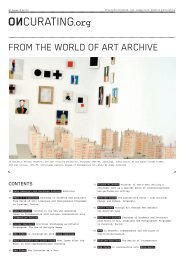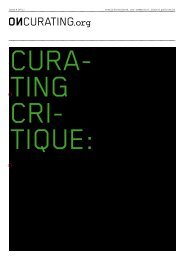Create successful ePaper yourself
Turn your PDF publications into a flip-book with our unique Google optimized e-Paper software.
085 Issue # 11/11 : PublIc Issues<br />
community-in-themaking<br />
Siri Peyer in an E-mail-Conversation with<br />
Jeanne van Heeswijk, conducted from February to June 2011<br />
siri Peyer: Dear Jeanne, before talking about some of your work more<br />
specifically, I wanted to <strong>as</strong>k you if you have a theoretical understanding<br />
or explanation of how you define public space?<br />
Jeanne van Heeswijk: Public space in most of our contemporary cities is<br />
highly regulated. The term suggests that social interaction is obviously<br />
implied, but actually it is not. We see more and more people feeling<br />
left out in what is often a clinical understanding of the public domain.<br />
Something we often seem to forget is that the public domain is not<br />
evident. It is a source of conflict between residents, developers, and<br />
government.<br />
Just to be clear: the public domain is more than what we describe <strong>as</strong><br />
public space: it is the actual physical space, the social interaction,<br />
the media, and the means of communication. All of these together<br />
determine someone's living environment. It concerns the space in which<br />
people live, and the relationships both with each other and with the<br />
outside world. To become an active citizen, you are not only a user of<br />
public space but you are also engaged in its creation and are an integral<br />
part of the image (imagining) of that space.<br />
The public domain is b<strong>as</strong>ed on the meeting and confrontation of people,<br />
cultures, and ide<strong>as</strong>. It is exactly in that confrontation that new ide<strong>as</strong><br />
and social formations originate. Public life is but for a small part<br />
oriented toward the physical environment. Furthermore, it is much more<br />
a process of social, economic, and cultural activities that move –<br />
certainly today – on various scale levels. At the heart of the processes,<br />
and especially those around which urban life revolves, cultural interventions<br />
are often the only manner in which an engagement in these pro-<br />
cesses can again be generated. We must no longer view the public domain<br />
solely <strong>as</strong> the result of economic and legal considerations, but instead<br />
we can start viewing and using it <strong>as</strong> the (per)formative b<strong>as</strong>is of a<br />
community-in-the-making.<br />
H<strong>as</strong> this understanding changed because of your practical<br />
experience?<br />
For this it is important that more friction is created. For friction to<br />
occur, there must be more communal participation in that space. To<br />
realize this communal use, people must feel that the space actually be-<br />
longs to them. The question for me became to create places in which<br />
we, in discussion with one another, can face up to the confrontation in<br />
order to address one another <strong>as</strong> co-producers of the city. Can we make<br />
this arena of tension visible and develop instruments that make it<br />
possible to intervene? Can we collectively develop a public domain in<br />
which everyone h<strong>as</strong> a place? And can we then develop the instruments that<br />
enable people to genuinely shape, deepen, sharpen, or question their<br />
daily surroundings. This needs a form of reciprocity, an exchange of<br />
knowledge, collectivization, and cohabitation in the process. (fig. 1,2)<br />
To <strong>as</strong>sist the building of urban spaces that allow for cultural, social,<br />
economic, and political changes, I started to create platforms where<br />
people are able to encounter each other and where, on the b<strong>as</strong>is of the<br />
meetings that take place, they can construct representations of their<br />
environment. In other words, I intervene in a given situation in such a<br />
way that those involved can incre<strong>as</strong>e the number and intensity of their<br />
ties. To this extent, I propose action programmes, incitements to conversation,<br />
sites of exhibition, and systems of circulation. For this,<br />
a practice of dealing with questions of urban spaces is needed, one that<br />
1 — Freehouse – Tomorrow's Market - speak your mind,<br />
2009, Rotterdam South. Photo: Jeanne van Heeswijk<br />
2 — Freehouse – Tomorrow's Market — show your style,<br />
2009, Rotterdam South. Photo: Marcel van der Meijs


![Download as PDF [10.6 MB]](https://img.yumpu.com/4266533/85/500x640/download-as-pdf-106-mb.jpg)

